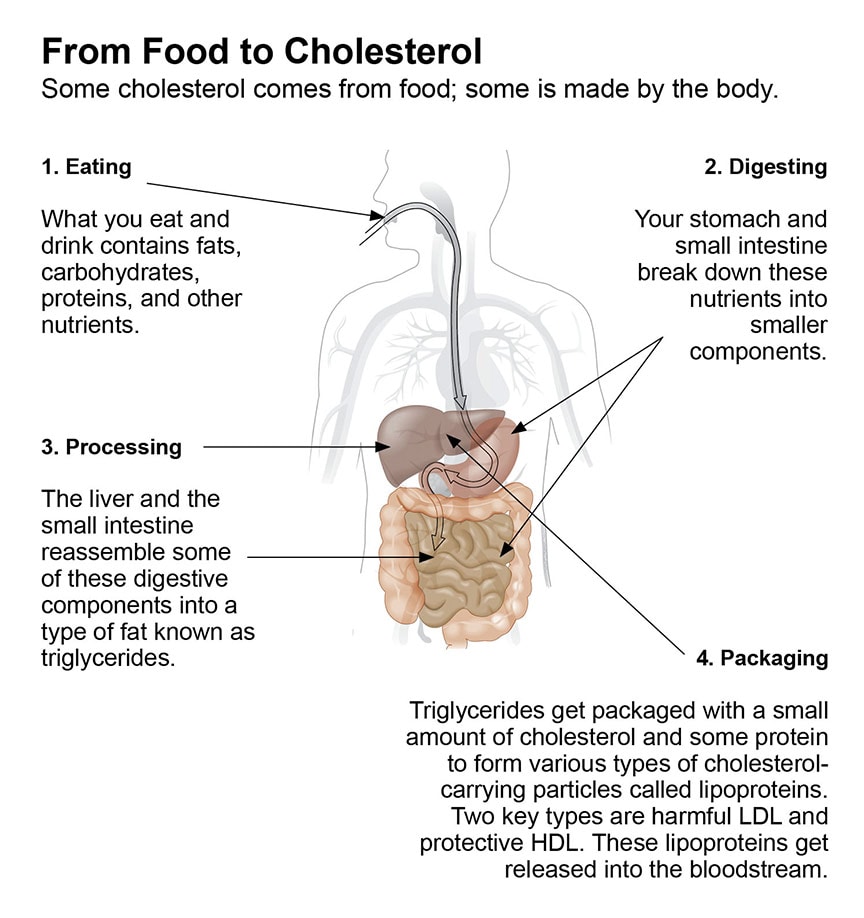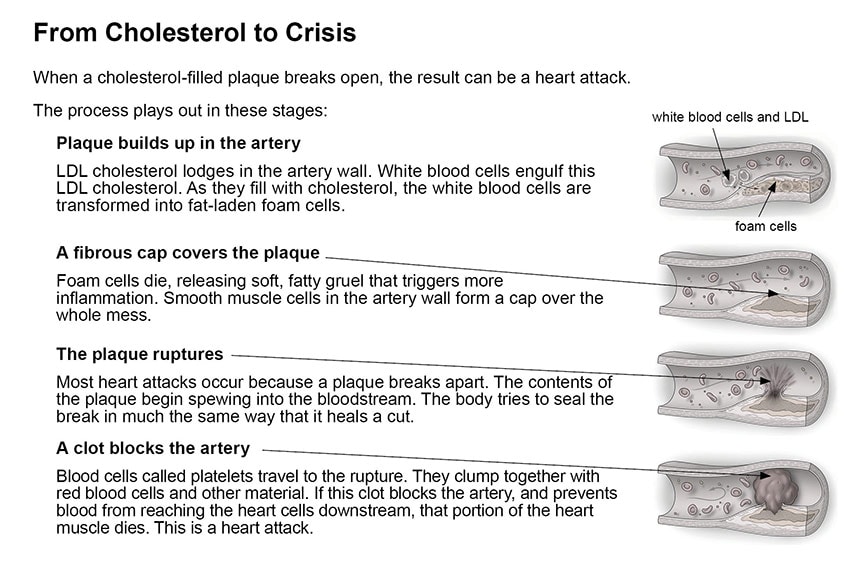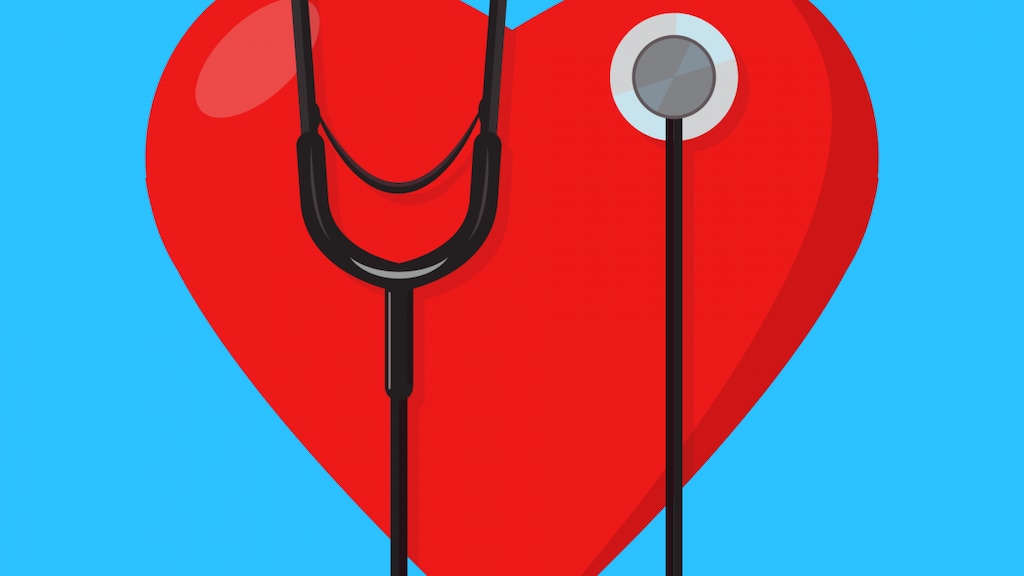
The human body needs some cholesterol. This type of fat is a building block for cell membranes, vitamin D, hormones like estrogen and testosterone, and more. Too much cholesterol in the bloodstream, though, can lead to clogged arteries around the body. Lowering high cholesterol with lifestyle changes, and medications if needed, can help protect you from heart attack, stroke, and other cardiovascular problems.
What is cholesterol?
Cholesterol is a type of lipid found in some foods. It also circulates in the bloodstream.
Cholesterol isn’t entirely the health villain it’s made out to be. Our bodies need cholesterol to make cell membranes, vitamin D, the bile acids needed to digest and absorb fats, and key hormones like testosterone and estrogen. Cholesterol is so important that the liver and intestines make it from scratch.
What is “bad” about cholesterol isn’t the substance itself—in fact, we can’t live without it—but how much of it ends up in the bloodstream.
The body packages cholesterol with protein into two main particles:
- Low-density lipoprotein (LDL), “bad” cholesterol. Too much LDL in the bloodstream helps create cholesterol-filled deposits, called plaque, that grow inside arteries. These are responsible for angina (chest pain with exertion or stress), heart attacks, and most types of stroke.
- High-density lipoprotein (HDL), “good” cholesterol. HDL grabs cholesterol from plaque and from cholesterol-carrying particles in the bloodstream and takes it to the liver for removal.

Cholesterol and cardiovascular disease
Cholesterol is a key cause of narrowed and blocked arteries.
A buildup of cholesterol in an artery is called plaque. When plaque grows inside an artery, it shrinks the open space through which blood flows. A decrease in blood flow means the artery can’t deliver enough oxygen-rich blood to the tissue or organ it supplies.
When plaque builds up in coronary arteries, which nourish hard-working heart muscle, it can cause two major problems:
- chest pain when the heart needs to work harder, for example, during physical activity or stress; this pain is known as angina
- heart attack when a plaque breaks open
The buildup of plaque in arteries supplying the brain can cause a stroke. Plaque also can cause:
- leg pain that comes on with walking or exercising and goes away with rest, called intermittent claudication
- sexual problems, such as erectile dysfunction in men and difficulty with arousal, lubrication, or orgasm in women

Your cholesterol test
A blood test is the only way to know if your cholesterol is in the healthy range.
That’s because high cholesterol usually doesn’t cause any symptoms.
A cholesterol test is also known as a full lipid panel because it measures the amounts of several lipids in the bloodstream.
You will get the most accurate results if you don’t eat or drink anything except water from bedtime the night before until you have the test. Eating can temporarily change the amount of triglycerides in the blood. (After a meal or snack, triglycerides can be so abundant they make the blood look milky.)
Getting the test is easy. It is a simple blood draw.
A full lipid panel measures:
- LDL cholesterol
- HDL cholesterol
- triglycerides
- total cholesterol (the sum of all cholesterol-carrying particles in your blood)
Cholesterol levels for adults
If you aren’t taking cholesterol-lowering medication, here’s what your numbers mean:
| Total cholesterol level | Category |
|---|---|
| Less than 200 milligrams per deciliter of blood (mg/dL) | Desirable |
| 200–239 mg/dL | Borderline high |
| 240 mg/dL and above | High |
| LDL cholesterol level | LDL cholesterol category |
| Less than 100 mg/dL | Optimal |
| 100–129 mg/dL | Above optimal |
| 130–159 mg/dL | Borderline high |
| 160–189 mg/dL | High |
| 190 mg/dL and above | Very high |
| HDL cholesterol level | HDL cholesterol category |
| Less than 40 mg/dL | Low (likely to increase heart disease risk) |
| 60 mg/dL and above | High (likely to decrease heart disease risk) |
| Triglyceride level | Triglyceride category |
| Less than 150 mg/dL | Normal |
| 150–199 mg/dL | Borderline high |
| 200–499 mg/dL | High |
| 500 mg/dL and above | Very high |
If you are taking medicine for high cholesterol, your doctor may set goals for your cholesterol levels based on your personal risk of heart disease and stroke.
What’s your cardiovascular risk?
Many other things besides cholesterol contribute to the health of your heart and blood vessels.
Some of them you can't control, like your age, your sex, or your genes and family history. But there are many you can control.
You can help control the following factors that increase your chances of developing heart disease, having a heart attack or stroke, or developing some other form of cardiovascular disease:
- high cholesterol or triglycerides
- high blood pressure
- high blood sugar or diabetes
- being overweight or obese
- not exercising
- smoking
- an unhealthy diet
Factors that lower your chances of getting heart disease include:
- a healthy diet
- regular exercise
- high HDL
The best ways to estimate your odds of having a heart attack or stroke are to talk with your doctor and to use a risk calculator developed by the American Heart Association and American College of Cardiology.
Benefits of lowering cholesterol
If your cholesterol is high, lowering it has many benefits—especially if lifestyle changes are part of the solution.
Lowering the amount of harmful LDL in your bloodstream reduces your odds of developing heart disease or having a heart attack. But (as they say on late night TV) wait, there’s more.
Reducing your total and LDL cholesterol levels also decreases your risk of stroke. It helps protect the arteries feeding your brain from plaque buildup, which can cut off blood supply to part of the brain.
When cholesterol-clogged arteries cause chest pain (angina) during physical activity or stress, lowering cholesterol along with exercise, stress management, and medications can shrink the plaque causing the problem. This medical therapy can be as effective as artery-opening angioplasty or bypass surgery—without the risk.
These lifestyle changes also help with weight management. A healthy weight helps protect against many diseases and can help you live longer.
How to lower cholesterol
You can do many things to lower your cholesterol and improve the health of your heart and arteries including making lifestyle changes and taking medication.
Lifestyle changes
If your total cholesterol, LDL cholesterol, or triglycerides are high, making changes to your lifestyle is the best place to start. These changes not only help you control your lipids, but are good for every part of you, from your brain to your toes. Some helpful lifestyle changes can include:
Eat for heart health
Switching to a healthier diet should be a cornerstone of your efforts to lower cholesterol and prevent heart disease. Here are some healthy eating strategies:
- Go easy on saturated fat, found in red meat, full-fat milk and dairy foods, and palm and coconut oils.
- Focus on “good” fats from fish and plants, such as avocados, nuts, olive oil, and vegetable oils.
- Fill up on whole foods, including vegetables, fruits, and whole grains. They are full of nutrients and fiber and tend to have fewer calories and sodium than processed foods.
- Cut back on sugar and refined carbohydrates, like white bread, white rice, bagels, soda, ice cream, and the like. Sugary and processed foods quickly boost blood sugar and insulin (the hormone needed to use sugar), and don’t deliver as many nutrients as whole foods.
Lose weight if needed
Modest weight loss, even just 5% to 10% of your starting weight, can significantly improve cholesterol and triglyceride levels.
Get going with exercise
Being more active can lower harmful LDL and raise protective HDL. A good goal is 150 minutes of moderate-intensity exercise, like brisk walking, each week. That’s just 30 minutes a day, five days each week.
Medications
If lifestyle changes aren't doing enough to improve your cholesterol and triglyceride levels, or if your heart disease risk is medium to high, you may benefit from taking medication. Several different types of medication are available:
- Statins. These are the most effective and most widely used medication for lowering the level of harmful LDL. Seven different statins are on the market; five of them are available as generic drugs.
- Bile acid binders. These are the oldest form of cholesterol-lowering medication. They can be used as an alternative to a statin.
- Cholesterol-absorption inhibitor. This medication is often used in combination with a statin.
- Fibrates. These medications are used to lower high triglycerides.
- Fish oil. Fish oil is a healthy and effective option for lowering triglycerides.
Who should take a statin?
An individual’s cardiovascular risk is used to determine if he or she should take a cholesterol-lowering statin.
According to new guidelines from the American Heart Association and American College of Cardiology, a daily statin is recommended for:
- anyone age 21 or older with an LDL level above 190 mg/dL
- anyone who has been diagnosed with cardiovascular disease; has had a heart attack, stroke, or transient ischemic attack (“mini-stroke”); has peripheral artery disease; or has had bypass surgery or angioplasty
- anyone age 40 to 75 who has diabetes
- anyone age 40 to 75 who doesn't have cardiovascular disease but has a greater than 7.5% chance of having a heart attack or stroke in the next 10 years
When high cholesterol runs in the family
Some people have a genetic disorder that significantly increases heart disease risk.
Familial combined hyperlipidemia. This inherited disorder causes the liver to make too much harmful LDL. That leads to very high LDL levels, often beginning during the teenage years.
Familial hypercholesterolemia. In familial hypercholesterolemia, the liver can't remove LDL particles from the blood. That causes LDL levels to soar, often at an early age.
Treating these disorders
Treating either of these conditions is like treating regular high cholesterol—a combination of lifestyle changes and medication—only more intense. Some people need a procedure called LDL apheresis to filter LDL out of the bloodstream.
Talk with your primary care doctor or a cardiologist if you’re concerned about high cholesterol and your options for getting it under control.
Talk with your doctor
Whether this is your first visit or a follow-up, asking your doctor these questions might be helpful:
- How often should I have my cholesterol checked?
- What do my cholesterol numbers mean?
- Could other health problems, or the medications I am taking, give me high cholesterol?
- What are the dangers of having high cholesterol?
- What is the best diet for lowering cholesterol?
- Can exercise help me control my cholesterol?
- Do I need to take a cholesterol-lowering medication?
- How do I know if my cholesterol-lowering medication is working?
- What side effects of cholesterol-lowering medications should I be on the lookout for?




